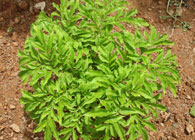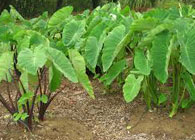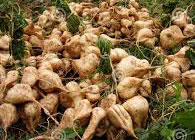
CASSAVA

Cassava or tapioca (Manihot esculenta Crantz) belonging to the family Euphorbiaceae (Dicotyledonae) is a diploid (2n = 36). It is a native of south America widely cultivated in the topics especially in South America, Mexico, Central America, the Caribbean Islands, Africa (East, West, South& Central) and Asia (India, Malaysia, Indonesia, China, Myanmar, the Philippines, Sri Lanka, Thailand and Vitenam). It is an erect growing shrub branched or unbranched with palmately partite leaves. It is monoecious and protogynous. The adventitious roots store food and form the tubers. In India, it occupies 0.24 m ha with a production of 5.1 million tonnes. It is cultivated predominantly in the southern states of which Kerala and Tamil Nadu are responsible for 61% and 29% of area and 55% and 41% of production respectively. It is also grown in Andhra Pradesh, Assam, Karnataka, Madhya Pradesh, Pondicherry, Nagaland, Tripura, Mizoram and the Andaman & Nicobar group of Islands. Cassava tubers being rich in starch, is an important subsidiary food. It forms a raw material for industry (starch& sago) and is a component of animal, fish and poultry feeds. Cassava starch has more purity than potato or maize starch, the tubers being practically free from non-starchy constituents such as protein and lipids and the extraction is easier and direct. Thailand and India are major exporters of cassava starch to international market where it is used as filler material in paints, medicine and health drinks. Recently it has found place in the manufacture of biodegradable plastic. It is processed into food products like chips, sago, vermicelli, pappads etc. Technology has been developed for economic production of alcohol from cassava tubers. The crop provides 300 K calories of energy per day to more than 400-500 million people in the world especially in the under developed countries. Cassava crop is raised by planting stem cuttings. Mature healthy stems of 8-12 month growth having thickness of 2-3 cm free from diseases and pests should be selected for planting. A stake length of 15-20 cm and planting depth of 5 cm are generally practiced. Stakes are planted vertically on mounds, ridges or well tilled plot at a spacing of 90 x 90 cm. In non-traditional areas with 4-5 months limited rainfall (eg., Andhra Pradesh ) stakes can be closely planted in nursery beds under irrigation and later transplanted (20-25 days) to field as and when the rains set in. Spacing of 75 x 75 cm is recommended for semi and non-branching varieties , 90 x 90 cm, 90 x 75 cm(eg., Madhya Pradesh) and 75 X 90 cm(eg., Tamil Nadu) recommended for non-branching varieties.
COLEUS

Plectranthus rotundifolius or Solenostemon rotundifolius, called Chinese potato in Indian English and often referred to as native potato or country potato in Africa, is a perennial herbaceous plant, of the mint family (Lamiaceae), native to tropical Africa, cultivated in parts of West Africa, South Africa, Madagascar, South Asia and Southeast Asia for its edible tubers. Wild varieties are found in the grasslands of East Africa. It is one of three species of the mint family that produce edible tubers and closely related to the flowering coleus plants familiar to many gardeners outside of these regions as ornamentals. All three of these species are native to Africa and members of the genus Plectranthus (sometimes classified as members of the genus Solenostemon and formerly classified as part of the now defunct genus Coleus). The others are Plectranthus esculentus and Plectranthus edulis, native to southern Africa and Ethiopia respectively. P. rotundifolius is the only one of these tubers whose cultivation has spread beyond the continent of Africa.
ELEPHANT FOOT YAM

Elephant yam is a striking aroid with a flower spike crowned with a bulbous maroon knob and encircled by a fleshy maroon and green-blotched bract. The solitary leaf, which emerges after the flowering parts, resembles a small tree. Amorphophallus paeoniifolius has been in cultivation throughout tropical Asia for centuries. The tubers are the third most important carbohydrate source after rice and maize in Indonesia. They are also consumed widely in India and Sri Lanka, although elsewhere they are seen as a famine crop, to be used when more popular staples, such as rice, are in short supply. Elephant yam belongs to the same genus as the crowd-pulling titan arum (Amorphophallus titanum). It should not be confused with Dioscorea species, which are also known by the common name yam, but belong to a different plant family (Dioscoreaceae). In particular it should not be confused with elephant’s foot yam (Dioscorea elephantipes) from South Africa.
SWEET POTATO

Sweet potato (Ipomoea batatas (L.) Lam.) is a dicotyledonous plant native to Central America. Its normal life time ranges from 3 to 7 months. Tuberous roots are the economically important part of the crop. It is a short day plant and will flower when the day length is less than 13 hours/day. The crop is propagated through slips or sprouts in temperate regions and through stem cuttings in tropical areas. Sweet potato is grown in nearly all parts of the tropical and sub tropical world and in warmer areas of temperate regions. The crop has been a staple food crop of many tropical communities for centuries and it continues to be an important source of food in many poor countries. Sweet potato is rich in carbohydrate and vitamins.
TARO

Taro belongs to the genus Colocasia, within the sub-family Colocasioideae of the monocotyledonous family Araceae. Because of a long history of vegetative propagation, there is considerable confusion in the taxonomy of the genus Colocasia. Cultivated taro is classified as Colocasia esculenta, but the species is considered to be polymorphic. There are at least two botanical varieties: i) Colocasia esculenta (L.) Schott var. esculenta; ii) Colocasia esculenta (L.) Schott var. antiquorum (Schott) Hubbard & Rehder which is synonymous with C. esculenta var. globulifera Engl. & Krause. C. esculenta var. esculenta is characterised by the possession of a large cylindrical central corm, and very few cormels. It is referred at agronomically as the dasheen type of taro. C. esculenta var. antiquorum, on the other hand, has a small globular central corm, with several relatively large cormels arising from the corm. This variety is referred to agronomically as the eddoe type of taro. Most of the taro grown in the Asia/Pacific region is of the dasheen type.
YAM

Yam is the common name for some plant species in the genus Dioscorea (family Dioscoreaceae) that form edible tubers. These are perennial herbaceous vines cultivated for the consumption of their starchy tubers in Africa, Asia, Latin America, the Caribbean and Oceania. There are many cultivars of yam. Although some varieties of sweet potato (Ipomoea batatas) are also called yam in parts of the United States and Canada, it is not part of the family Dioscoreaceae but belongs in the unrelated morning glory family Convolvulaceae. The true yam is a versatile vegetable. It can be barbecued, roasted, fried, grilled, boiled, baked, smoked and when grated it is processed into a dessert recipe.
YAM BEAN

Pachyrhizus erosus, commonly known as jicama or Mexican yam, or Mexican turnip, is the name of a native Mexican vine, although the name most commonly refers to the plant's edible tuberous root. Jícama is a species in the genus Pachyrhizus in the bean family (Fabaceae). Plants in this genus are commonly referred to as yam bean, although the term "yam bean" can be another name for jícama. The other major species of yam beans are also indigenous within the Americas.
Flowers, either blue or white, and pods similar to lima beans, are produced on fully developed plants. Several species of this crop occur, but the one found in [many] markets is Pachyrrizus erosus. The two cultivated forms of P. erosus are jicama de agua and jicama de leche. The latter has an elongated root and milky juice. The agua form has a top-shaped to oblate root, a translucent juice, and is the preferred form for market.




